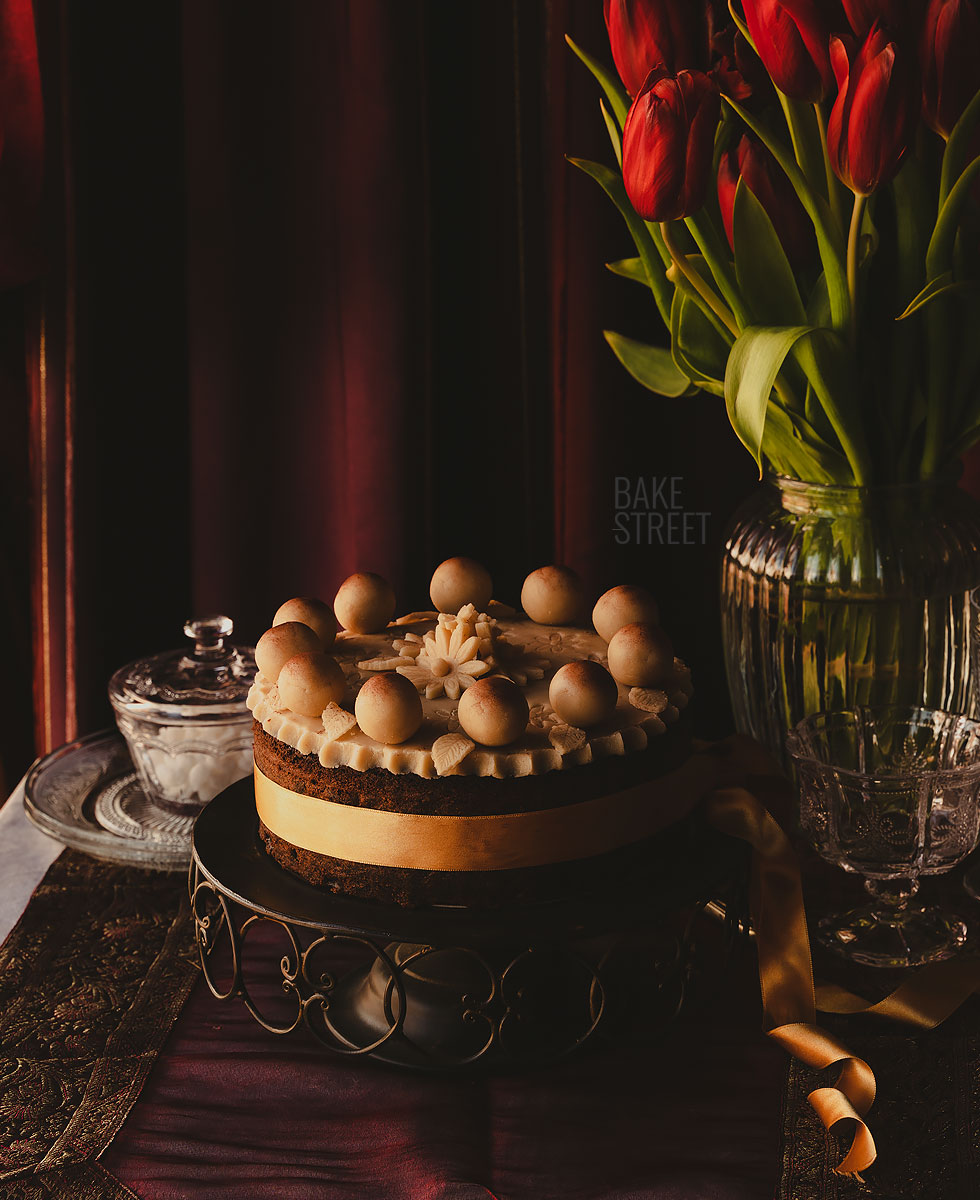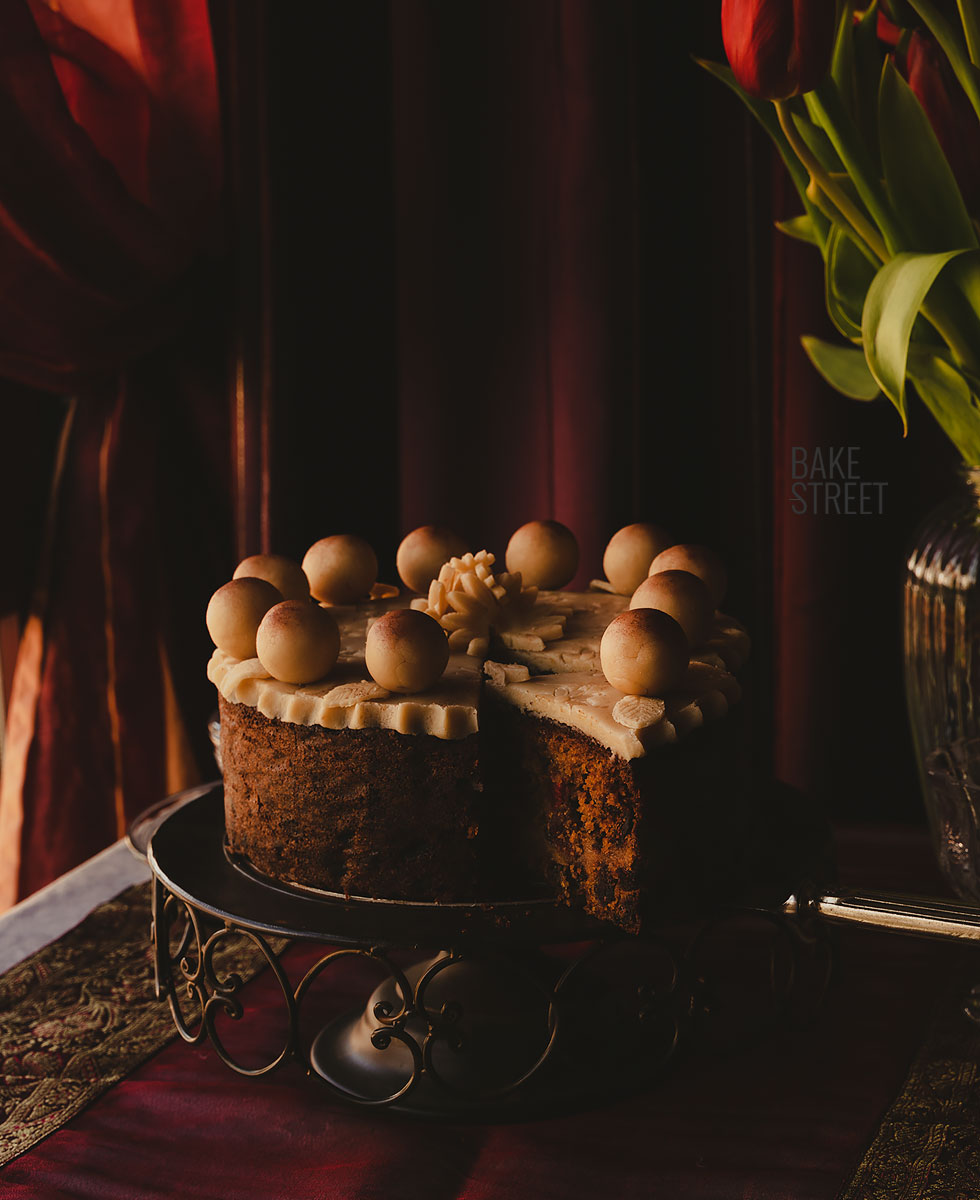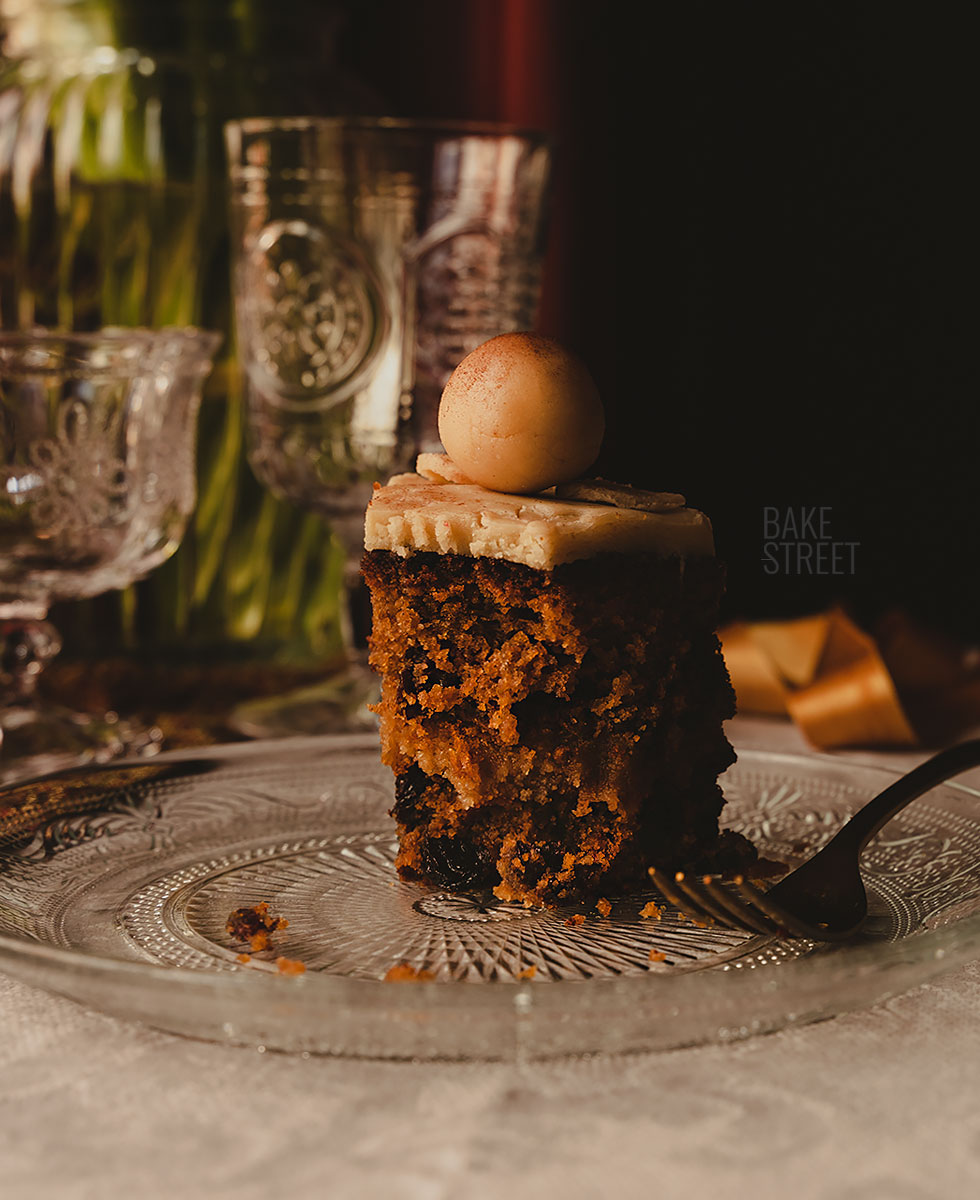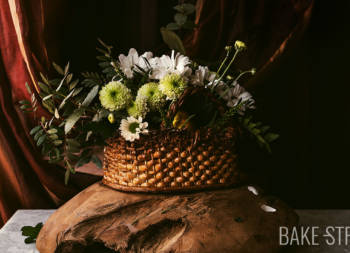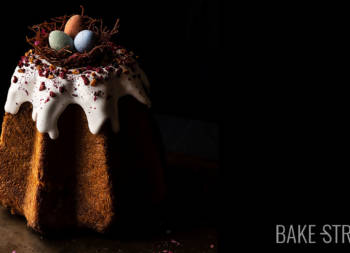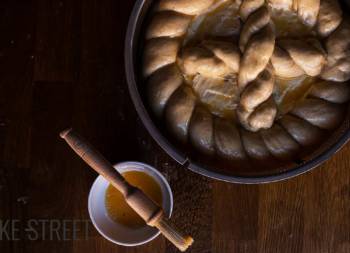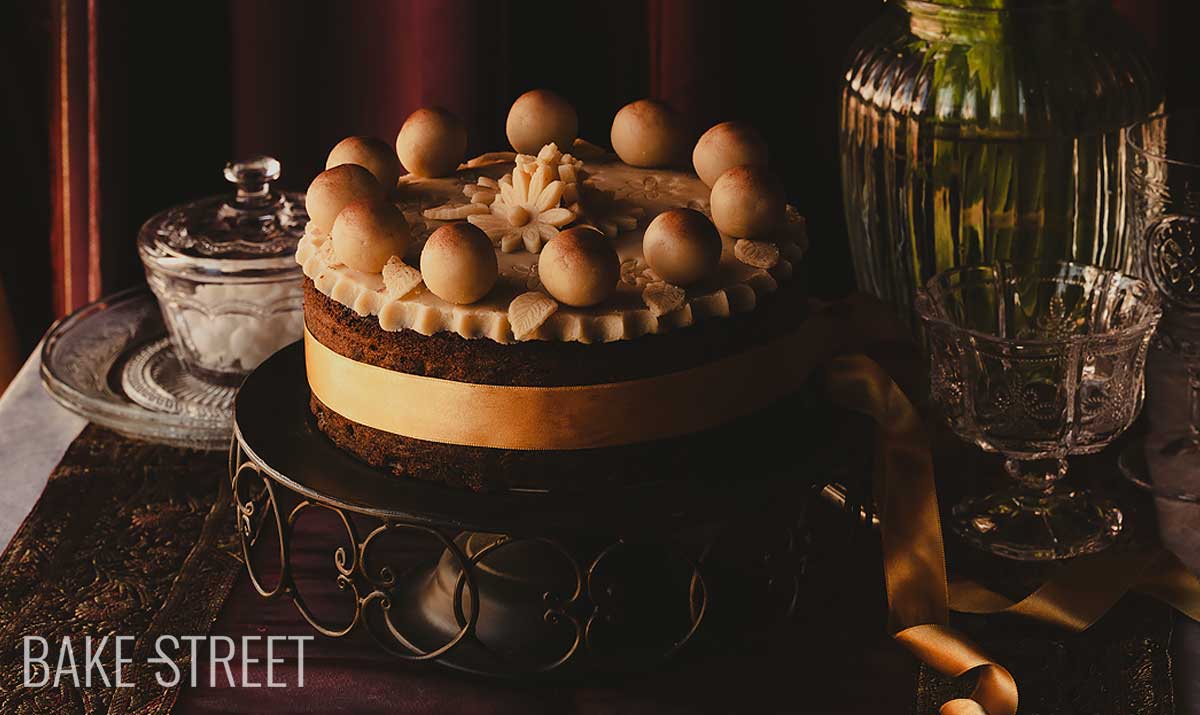
Easter Simnel Cake
Easter is coming soon and with it a lot of wonderful and great recipes like this Easter Simnel Cake from the UK. I couldn’t wait for these dates to arrive to share this marvel with you. Not only because it is an easy recipe to make, but also because the result is a sensational cake… If you like Fruit Cakes- Cake aux fruits or fruit sponge cakes like Mary Berry’s, this one will blow your mind.
As it usually happens to me with these recipes, I fell in love. To infinity. And the more information I looked for about it, the more I liked it. I found some absolutely spectacular designs. Way beyond the top circle and the 11 marzipan balls. In fact, the cake that I left you, is inspired by the one from Marks & Spencer which was, without a doubt, the one I liked the most of all.
This fruit cake, Simnel Cake, is one of the most mysterious traditional pastries in the UK.
According to historian Annie Gray – “The Simnel Cake is the subject of legends, in fact, most of them totally unfounded”.
It is a sponge cake dominated by dried fruit and based on four quarters sponge cake, same amount of sugar, flour, eggs and butter. It is also seasoned with spices, citrus zest and even Brandy, if desired. The peculiarity of this cake, in addition to the top layer of marzipan is another layer of marzipan inside, right in the middle of the cake, which is baked together with the batter.
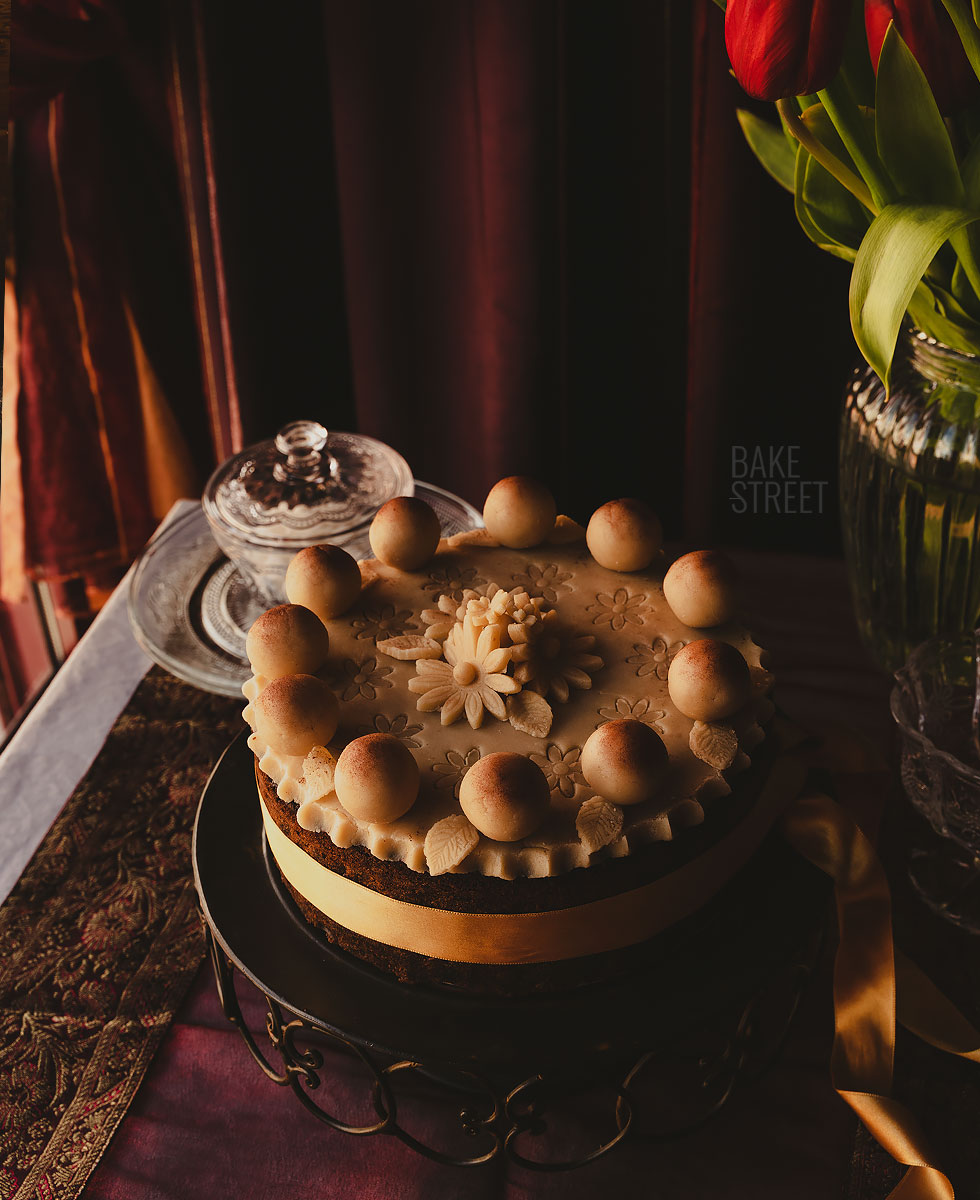
Top decoration includes 11 marzipan balls representing the apostles, excluding Judas. The traditional way is to toast the marzipan, either with the oven grill or with a blowtorch. In my case, I hope the more traditional ones will forgive me, since I didn’t like the final finish by toasting it, I decided to brush it with unsweetened cocoa powder to simulate that finish.
On the other hand, I have modified the traditional recipe a bit, adjusting it to my personal taste. In addition, I decided to reduce the final amount of sugar because it seemed excessive and, when I tasted it, I did not find it pleasant. It was very cloying and tiring to eat.
Simnel Cake origin.
This incredible fruit and marzipan cake dates back several centuries, although the version we enjoy today is very different from the original recipe.
Museum curator Emma Heslewood, who writes The Cake Historian blog, states the following:
“There are other versions of Simnel Cake, different from the original, because in the beginning it was a fruit loaf. All cakes started out as sweet breads and then evolved into textured cakes when plantations made sugar more readily available. Before that, people could use very little honey or fruit.”
The competition for being the home of the Simnel cake is very close. There are three places in contention and, although their recipes differ quite a bit, they all agree on omitting milk and butter, ingredients forbidden during Lent.
Types of simnel.
The first is the Shrewsbury simnel, a pie made from plums and covered with a crisp crust made with flour, saffron and water. The saffron adds a characteristic and peculiar yellow color. It was boiled for several hours in a mold, like a Christmas pudding (some time ago I let you how to make it, it’s too old so is in Spanish), then covered with the dough, brushed with egg and baked, resulting in a firm pie with a long shelf life.
Heslewood says, “Shrewsbury is the earliest cake on record, but really it could have been from anywhere, as everyone was making their own sweet breads and cakes.”
Second type is Devizes star simnel, a star-shaped cake made with currants and lemon peel, colored with saffron, baked and glazed. The Wiltshire Heritage Museum preserves an original recipe for the local version.
The third comes from the town of Bury, in Lancashire, and is the closest to today’s Simnel. It is made with walnuts, cherries and citrus peel, covered with marzipan and decorated with sugar balls. The city proudly promulgated its cake in the 19th century, even presenting a 32 kg (70 lb) Simnel to Queen Victoria in 1863, perhaps for that reason it has become the most popular and traditional.
Today it is not common to find this cake made with saffron. It is said that it is possible that some stingy chefs substituted this spice for allspice, since it was much cheaper.
Another difference in its preparation is that, in the past, the cake was boiled and then baked, while nowadays, it is baked and then browned under the grill.
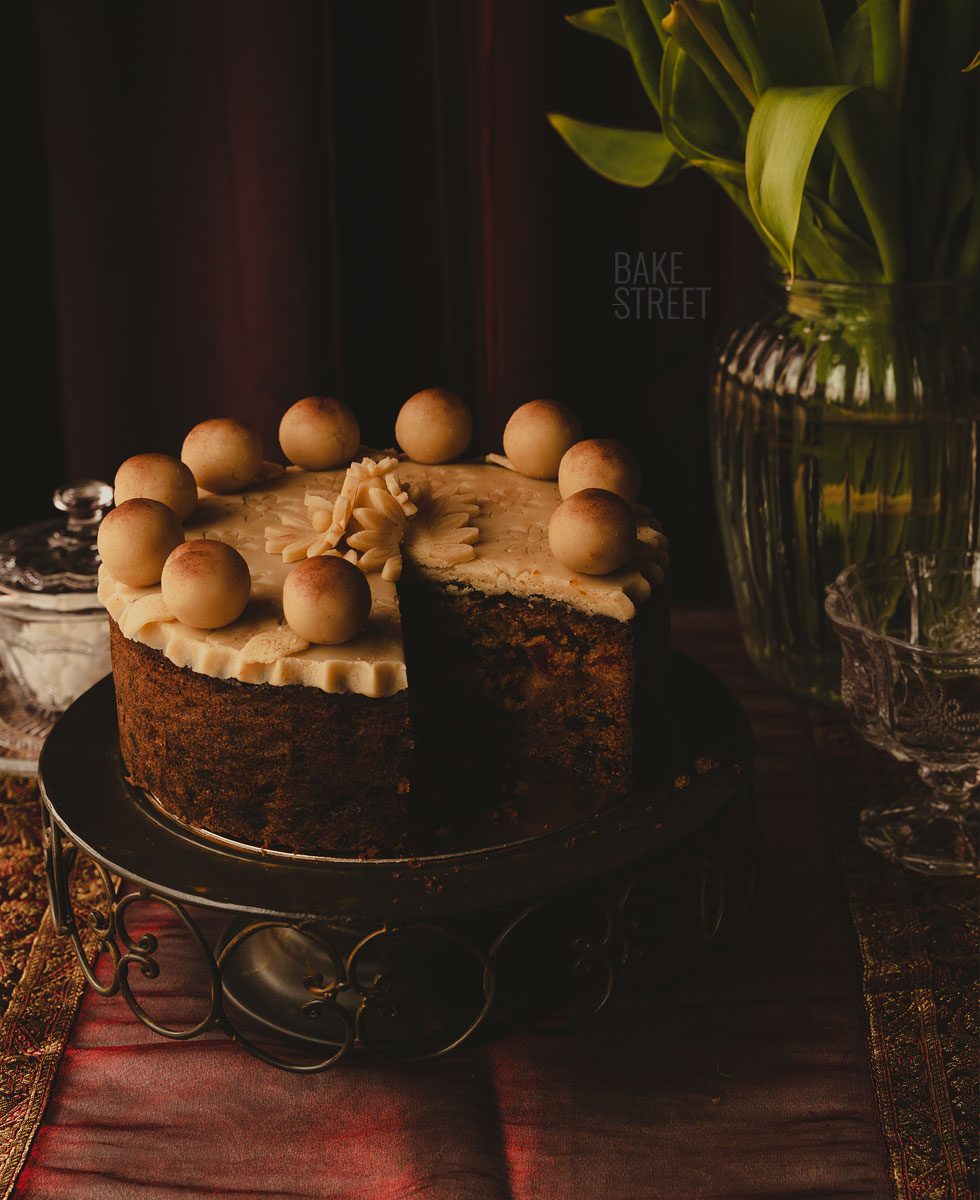
What is the meaning behind the word “Simnel”?
There are some strange and fascinating theories about the origin of this cake’s name. One of the funniest is a 19th century tale about an elderly couple named Simon and Nell.
It is said that the creation of this cake, came from leftover Christmas ingredients that the elderly couple used to make a cake for spring. A problem arose as to how to go about baking the cake and the two argued over what to do with the dough; Simon wanted to boil it and Nell wanted to bake it.
They came to an agreement, decided to do both and their invention gave rise to the name, Sim-Nell.
Other legends suggest that the cake owes its name to Lambert Simnel, a pretender to the throne in the time of Henry VII. Victorian novelist Elizabeth Gaskellreferred to this unlikely theory in a letter to a friend in 1838, in which she recounted memories of her childhood eating Simnel Cake on Mothering Sunday in Knutsford, Cheshire.
The truth is actually much more vulgar. Simnel probably comes from the Latin word “simila” meaning fine wheat flour. The cake’s ancestor, simnel bread, was on the British menu as early as the 11th century.

According to an entry in the Winchester Annals of the year 1042.
Edward the Confessor ordered that, whenever he or his successors wore the crown at Winchester, Worcester or Westminster, the local abbey should receive him with “a hundred simnels and a wine barrel.”
Similarly, the Chronicle of the Battle of the Abbey, which was completed in the early 12th century, records that, after founding the monastery, William the Conqueror left the monks “a memorial of his affection, by appropriating for their daily use bread fit for the royal table, which is commonly called simenel.”
In the year 1266, Henry III decreed that “bread made as simnel” was of such exceptional quality that it “should weigh two shillings less than wasted bread.”
However, in the early 13th century, the word “simnel” was also used to designate a type of cake. In his dictionary (circa 1225), John de Garland explains that simineus was the French word for Latin placenta. This was a kind of cake that was displayed in store windows to attract the attention of hungry students at the University of Paris. A passage in Cato the Elder’s De agricultura suggests that, in ancient Rome, placenta (cake) was made from semolina dough, cheese and honey, although it is not known whether it was made in the same way in medieval France.
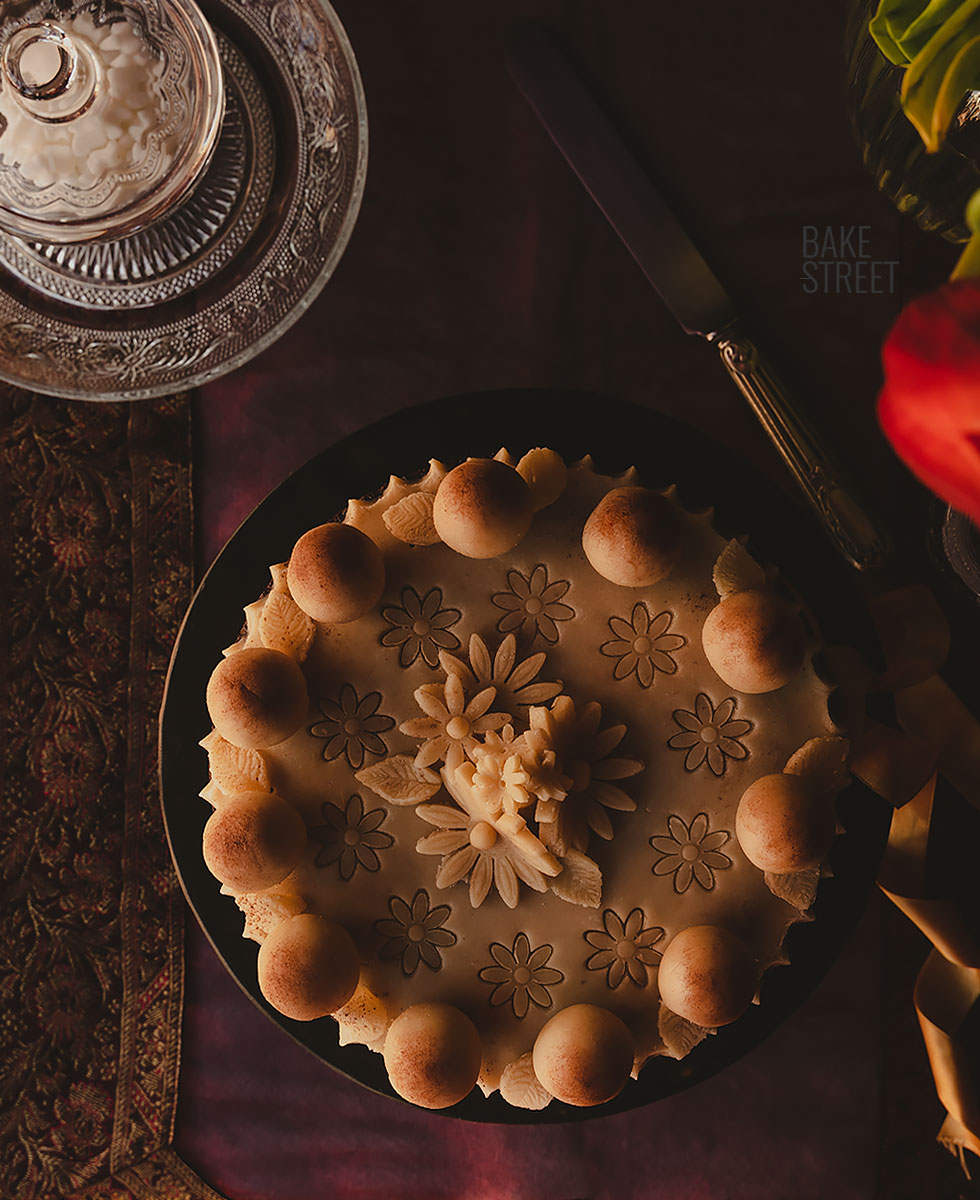
How did the Simnel become a traditional Easter cake?
Simnel is consumed mainly in the United Kingdom and in countries with a Christian population descended from British and Irish immigrants. It was originally associated with Lenten festivities, including the fourth Sunday (known as Laetare Sunday), which also coincides with Mother’s Day Sunday. But, nowadays, this cake is consumed during Easter.
Today, Mother’s Day, is considered a celebration of mothers, but in Tudor times it was a rare day off for servants to visit their “mother”, church, if they could, bringing her cakes and flowers as gifts.
Historian Pen Vogler, author of Scoff: A History of Food and Class in Britain, says that simnel cake was prepared for the occasion, which was a welcome respite after the fasting season. He notes that the poet Robert Herrick wrote in 1648, “I’ll to thee a simnel bring, Gainst though go’st a mothering.”
However, Dr Annie Gray, panelist on Radio 4’s The Kitchen Cabinet and author of The Official Downton Abbey Cookbook, believes that much of the symbolism around the simnel cake is mythology, going back to the Victorians who were fascinated by telling “tall tales”. He believes the connection to Mother’s Day is fairly current, while marzipan balls didn’t become fashionable until the 1970s, after appearing briefly in the Edwardian era.
Heslewood agrees that the Victorians had a lot to do with fixing the “cake calendar.”
He says, “The 19th century was the heyday of pie consumption, where recipes became more formally established, as with Mrs. Beeton, and pies became traditions with the calendar.”
This is an example of how such a humble preparation, such as a fruit loaf, has evolved over the years into such an incredibly aromatic, tasty and aesthetically beautiful cake.
Recipe Easter Simnel Cake
SPONGE CAKE:
- 225 g cake flour, sifted
- 225 g unsalted butter, room temperature
- 4 large eggs
- 100 g light muscovado sugar
- 75 g sugar
- 1 tsp ginger powder
- 1/2 tsp cinnamon powder
- 1/4 tsp nutmeg
- 4 allspice berries, mashed or 1/4 tsp in powder
- 2 tsp natural vanilla extract
- zest from one lemon, one orange and one tangerine
- 10 g baking powder
- pinch of salt
- 175 g sultanas
- 175 g dehydrated cranberries
- 50 g candied cherries, cut in quarters
- 220 g fresh orange juice
MARZIPAN:
- 400 g ground almonds
- 385 g powdered sugar
- 20 g honey
- 65 g water
FOR DECORATING:
- bitter orange or apricot marmalade
- cocoa powder, unsweetened
MATERIAL WE WILL NEED AND SHOW IN THE VIDEO:
- stand mixer* or hand electric mix
- ceramic KitchenAid bowl*
- push pan 20 cm in diameter
- marble roller*
- scraper*
- digital scale
- sharp knife (mine from Pallarés*)
- flower cutters with ejector (mine are these)
- pastry brush*
- cooling rack
- Romantic glass*
*You have a 5% discount on the website Claudia&Julia using this code BAKESTREET. Delivers throughout Europe.
Instructions
FIRST DAY
Prepare marzipan.
- In a bowl, add the ground almonds together with powdered sugar, honey and 3/4 parts of water. Mix.
- Observe the marzipan and continue kneading with your hands. Add the remaining amount of water, if necessary, and continue mixing. We must obtain a manageable almond paste that does not crumble. The final amount of water will depend on the degree of drying of the almond, the older it is, the more water it will need.
- Form a cylinder, cover with plastic wrap and let stand for 2 hours, ideally overnight in the refrigerator.
Hydrate the dehydrated fruits.
- In a bowl incorporate the raisins/sultanas along with the dehydrated cranberries.
- Pour the orange juice and let stand for 6-8 hours.
- NOTE: We can heat the juice if we cannot carry out the specified resting time. The heat will help the fruits to hydrate sooner.
SECOND DAY
Prepare the inner marzipan disc.
- Remember to temper the marzipan at least 2 hours before working with it.
- Take 285 g of marzipan, approximately 1/3 of the total, and roll it out with a rolling pin. We will try to give a diameter a little smaller than the diameter of our mold.
- Set aside.
Prepare sponge cake.
- Preheat the oven to 300ºF/150ºC with heat up and down.
- Butter the inside of a 20 cm diameter springform pan and sprinkle with flour. Remove the excess. In my case, I lined the sides with baking paper (I have the feeling that the cakes rise better this way, but maybe it's just me).
- In the bowl of the KitchenAid, add the butter along with the two types of sugar. Whisk until you get a creamy texture.
- Stir in the spices along with the salt, vanilla and citrus zest.
- Add the eggs, one at a time, mixing well after each addition.
- Change the whisk for the flat beater and begin to incorporate the flour along with the baking powder, little by little, while mixing.
- Finally, add the rehydrated fruits (previously drained) and the candied cherries.
- Mix until they are evenly distributed throughout the mixture.
Bake.
- Divide the cake mixture into two equal parts.
- Pour one into the mold and smooth the surface, making sure it is uniform.
- Place the marzipan disc and press gently.
- Pour the rest of the cake mixture and smooth the surface so that it is as straight as possible after baking.
- Place in the oven at medium high and bake for 2 hours and 15 minutes or 2 hours and 30 minutes. After two hours of baking, check how the cake is. If it comes out clean when a toothpick is inserted, it is ready.
- Remove from the oven and place the mold on a rack. Let stand for 20 minutes and remove from the mold.
- Turn the cake upside down, that is, leave the base of the cake facing upwards, and let it cool on a wire rack. We will do this to level the top and make it straighter.
- Before it cools completely, when it is lukewarm to cold, wrap it well in plastic wrap and leave it at room temperature until the next day.
- NOTE: When the cake has a little heat inside, wrapping it in film helps to preserve its juiciness. In this case it is important because it is a rather dense cake.
Decorate with marzipan.
- Take 300 g of marzipan, this amount is the one we will use to form the upper disc.
- Roll out with a rolling pin to a diameter slightly larger than that of the mold. We will try to have a uniform thickness, in case we find it difficult, we can always use a leveling roller.
- Take the base of the mold and, with the help of a sharp knife, cut the excess.
- With the help of a cutter with a flower-shaped ejector, mark flowers on the marzipan disc forming a circle. Be careful not to press too hard because you will cut the marzipan. For the circle to be more or less perfect, we can carefully mark the marzipan with a ring, lid, cutter... So that it serves as a guide.
- Brush the top of the cake with the jam.
- Place the marzipan disc and press gently to adjust.
- On the edges, if desired, we can pinch the marzipan to give a more decorative appearance.
Create the top decorations and finish decorating the Simnel cake.
- With the rest of the marzipan, we will have about 250 g left, create the decorations.
- Form 11 balls of 16 g each with the marzipan.
- If you want, with the rest of the marzipan, you can create flowers of different sizes and leaves to decorate the surface. We will have to make a small marzipan support to hold the flowers.
- Once we have everything done, proceed to decorate. The ideal would be to hold the marzipan balls with honey, caramel.... In my case, as they kept rolling, I decided to hold them with toothpicks. It is not ideal, but there was no way to hold them well. If you do it this way, let your guests know so they know.
- Place the small marzipan support in the center and, around it, the flowers and leaves that we have created with the marzipan.
- Finally, the traditional recipe uses a blowtorch to lightly toast the marzipan balls. I did some tests and I didn't like the finish.... So I decided to brush each ball with cocoa powder to simulate the toasting and achieve a much more attractive appearance. But, feel free to use a blowtorch if you feel like it.
- Serve.

Notes
- I used a 20 cm diameter springform pan.
- Marzipan can be made and used on the same day, if desired. Letting it rest helps to enhance the aromas, as well as allowing the almonds to hydrate well.
- When you stretch the marzipan and observe that cracks form, it is a sign that it needs more water. No problem, add a little more water, mix very well and stretch again. Be careful when integrating the water, do it little by little, kneading very well and observing how it behaves. We can always add more, but it is not easy to remove the excess. It can be done by adding more almonds and icing, but this would force us to calculate the quantities to maintain a good proportion.
- As we stretch, remove scraps, join... The marzipan will dry out. Most likely, you will need to add a little water. You can do it with your hands, a coffee spoon or a bottle.
- This marzipan does not require baking because it does not contain egg whites.
- For the cake I used raisins/sultanas and cranberries, but if you wish, you can use any other kind of dried fruit you like; dried apricots, ginger, papaya....
- The final amount of fruits added for this cake should be 400 g.
- I recommend not omitting the candied cherries.

- To rehydrate the fruits we can use water or liquor, but in my case I wanted to enhance the orange flavor and so I decided to use natural juice for this purpose.
- I recommend hydrating the dehydrated fruits, this will make the final result incredibly juicier. Otherwise, the fruits will absorb the little moisture that the cake may contain and the result will be a much drier product. This cake, in itself, is dense.
- The light muscovado sugar can be replaced by the dark variety or even panela.
- The cake should be baked at a low temperature. If desired, after the first 90 minutes, it can be covered with aluminum foil to prevent excessive browning.
- With the resting time, the cake is much better. The flavors and aromas mature and the crumb becomes moist than when freshly baked. In fact, at the very least, I advise you to let it rest for 12-16 hours, well wrapped in plastic wrap, before decorating it.
- We can keep it wrapped in film and, if you wish, in an airtight container, for 7 days. It is possible that it lasts longer, but I have not tested it.

I promise you that this Easter Simnel Cake, will steal your heart. It has an incredible flavor and aroma, not to mention its texture... I dare say it's like a Stollen. The more we let it rest, perfectly wrapped, the more it improves its flavor and texture.
The aromas are enhanced, mature, and the moistness increases with each passing day. At first, when I made it, I thought it was too big... But I assure you that as the days went by, it became smaller. Undoubtedly the best cake/sponge cake I have eaten in a long time. I can't wait for you to try it and tell me about your experience!
Take my suggestion, prepare it a few days in advance and, once it is assembled with the marzipan, wrap it well in plastic wrap and let it rest in a cool, dry place, away from light. Fantasy.
I wish you a wonderful Sunday!
Lots of love,
Eva
Sources: Love Food, History Today
This post contains affiliate links.
